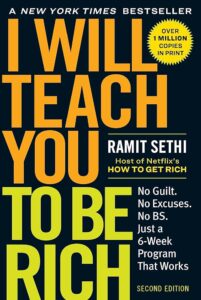
I Will Teach You to Be Rich: No Guilt. No Excuses. Just a 6-Week Program That Works (Second Edition)
Chapter 8: How to Maintain and Grow Your System
by DenzelleChapter 8 of I Will Teach You to Be Rich offers readers a practical yet philosophical guide on maintaining and growing a financial system that supports a fulfilling life. The focus shifts from simply accumulating wealth to building a system that balances financial security with the enjoyment of life’s meaningful moments. Drawing on concepts introduced earlier, the chapter emphasizes refining your financial strategy to align with your values and long-term goals.
At its core, the chapter asks readers to reflect on their reasons for seeking financial growth. Accumulating money without purpose, the author suggests, can lead to burnout and dissatisfaction. Instead, Ramit Sethi encourages setting goals tied to personal aspirations, such as traveling, pursuing creative hobbies, or making home improvements. This approach personalizes financial planning, reminding readers that the ultimate purpose of wealth is to enhance their quality of life.
The chapter also provides actionable strategies to support consistent financial growth. Sethi highlights the significance of automation in managing savings and investments, explaining how regular contributions to financial accounts can leverage the power of compound interest. Automating these processes reduces the need for constant decision-making, ensuring progress toward goals with minimal effort. This approach creates a structure that promotes both financial stability and personal freedom, helping readers stay on track without the burden of daily oversight.
Equally important is the concept of resource allocation, which balances disciplined saving with intentional spending. Sethi advocates setting aside a portion of income for guilt-free spending on things or experiences that genuinely bring joy. This strategy complements the idea of a “Rich Life,” where financial success is defined by the quality of one’s experiences, not just the numbers in a bank account. By integrating financial discipline with personal fulfillment, readers can sustain a system that supports both their aspirations and their well-being.
Tax planning, often an intimidating subject, is demystified in this chapter through Sethi’s straightforward explanations. He dispels myths about taxes being disproportionately burdensome as income grows and offers practical tips for minimizing liabilities. By exploring deductions, credits, and tax-advantaged accounts like 401(k)s and IRAs, readers can approach tax season with greater confidence and clarity. This perspective encourages proactive planning, transforming taxes from an unavoidable chore into a tool for financial growth.
An annual financial review is introduced as a vital practice to keep financial systems aligned with changing circumstances. This review helps readers reassess their goals, spending habits, and investment performance to ensure that their financial plan continues to serve their evolving priorities. Sethi also touches on long-term investment strategies, such as knowing when to rebalance portfolios, to maintain steady growth while avoiding impulsive decisions driven by short-term market fluctuations. These practices equip readers with a forward-thinking approach to managing their financial ecosystem.
Throughout the chapter, Sethi reinforces the notion that financial success should blend stability with enjoyment. Rather than rigidly saving or overindulging in spending, the chapter advocates for a system that allows for both growth and meaningful living. By focusing on what matters most—whether it’s family, personal passions, or charitable giving—readers are encouraged to define their version of a “Rich Life.”
A standout insight from the chapter is the importance of minimizing decision fatigue through automation. Automating savings and investments ensures consistent progress while freeing up mental energy for other pursuits. Additionally, Sethi’s approachable guidance on tax efficiency makes a complex topic more accessible, encouraging readers to view taxes as an opportunity to optimize their financial plans.
Ultimately, Chapter 8 blends practical strategies with a broader vision of financial freedom. It redefines wealth as more than a numerical goal, presenting it as a means to stability, personal growth, and the joy of living purposefully. Readers are empowered to create a financial system that not only supports their aspirations but also enhances their day-to-day lives.


0 Comments